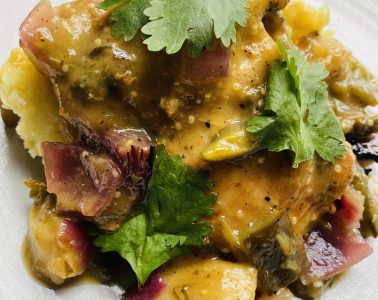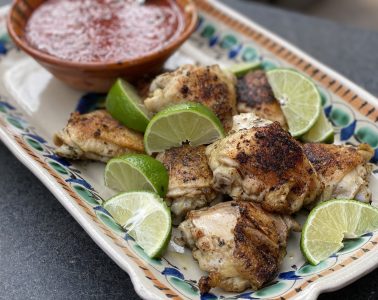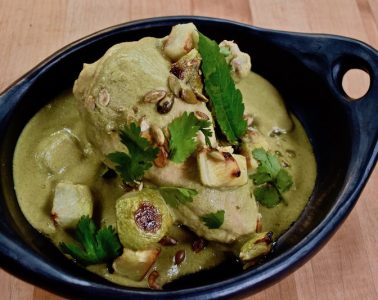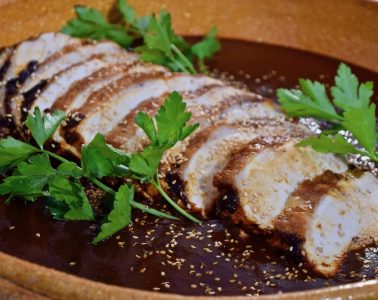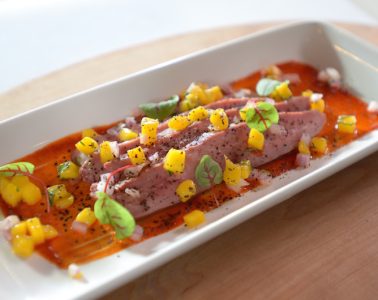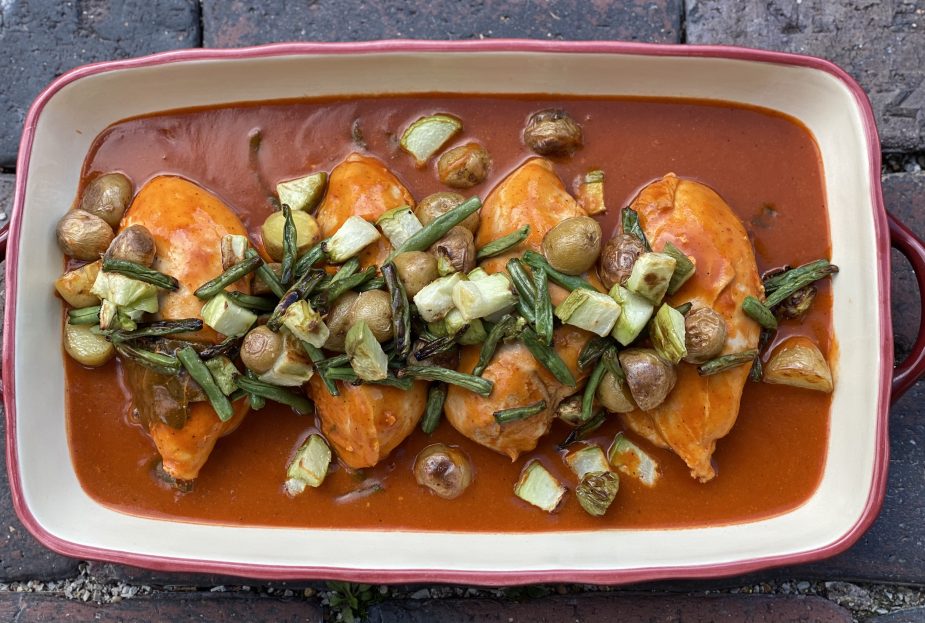
INGREDIENTS
- Salt
- 4 medium bone-in, skin-on (about 2 1/2 pounds total) medium chicken breast halves without wings
- 1/2 pound small (about 1 inch diameter) boiling potatoes (like fingerlings or the small multi-colored ones sold in lots of produce departments), cut in half
- 3 tablespoons vegetable or olive oil (divided use)
- 1 large (8- or 9-ounce) chayote, peeled or not, pitted, cut into ½-inch pieces
- About 5 ounces green beans, ends cut off, cut into thirds (about 1 packed cup)
- 4 dried (1 ounce) dried guajillo chiles, stemmed, seeded and torn into flat pieces
- 1 small (4-ounce) ripe tomato, cut in quarters
- 2 medium (4 ounces total) tomatillos, husked, rinsed and cut in half
- 6 garlic cloves, peeled and halved
- 2 cloves
- 1/2 teaspoon black peppercorns
- 1/2 teaspoon ground cumin
- 2 large (10- or 12-inch) hoja santa leaves OR 4 dried or fresh avocado leaves
- 6 tablespoons dried masa harina or plain fresh masa
INSTRUCTIONS
Poach the chicken. Pour 5 cups water into a large (4-quart) saucepan and add 1 teaspoon salt. Bring to a boil over medium-high heat, nestle the chicken breasts into the pan, making sure that they are completely submerged. When the broth returns to a boil, turn off the heat, cover the pot and let stand for 25 minutes (it’s fine if the chicken stays in the pot longer) while you’re roasting the vegetables and preparing the mole.
Roast the vegetables. Heat the oven to 425 degrees. In a large bowl, toss the potatoes and chayote with 1 tablespoon of the oil and a generous sprinkling of salt. Spread on a rimmed baking sheet, leaving behind as much oil as possible. (I put down a silicone mat or piece of parchment paper to ensure they don’t stick and to make clean up easy.) Roast for 10 minutes. In the same bowl, toss the green beans with another tablespoon of oil, sprinkle with salt and scoop onto the baking sheet with the potatoes and chayote. Use a spatula to turn over the potatoes, slide the pan back into the oven and roast for 20 minutes longer, until everything is tender and browned.
Clean the chicken breasts. Remove the breasts from the pot and pull off the skin. Using your hands or a small knife, peel the rib bones and the cartilage-like breast bone away from the meat. Cut out or pull out the large bone at the top, the one that connected to the wing. Connecting to that bone is the small wishbone that extends across the top of the breast. Pull it out. Pour the broth into a large measuring cup to use in the mole. You’ll use the saucepan in the next step—no need to wash.
Make the mole base. In an ungreased skillet over medium heat, lightly toast the chile pieces: use a metal spatula to press them for a few seconds onto the hot surface until they crackle, release their aroma and change color slightly; flip and toast the other side. Combine them in the large saucepan with the cut-up tomatoes, tomatillos and garlic. Add a cup of water, set over medium to medium-low heat, partially cover and simmer everything together for about 15 minutes. Transfer to a blender jar (liquid and all). Grind the spices in a mortar or electric spice milk, add to the blender and blend to a smooth puree.
Cook the mole. Wash and dry the large saucepan and set over medium heat. When hot, add the remaining 1 tablespoon of the oil, set a medium-mesh strainer over the pot, and, when the oil is shimmering hot, pour the puree into the strainer. Press the mixture through the strainer into the oil. Once you’ve pressed as much as possible through the strainer, discard what remains and stir the mixture in the pot for several minutes until it has thickened to the point that you can clearly see the bottom of the pot with each stir. Stir in 3 1/2 cups of the broth (you’ll use more when adding the masa). If you are using avocado leaves, add them to the pot; hoja santa is added later. Simmer over medium-low for 20 minutes.
Finish the mole. In a blender, combine 1 cup of the broth with the masa harina or fresh masa. Blend to combine, then strain the mixture into the simmering sauce. Whisk constantly as the sauce lightens in color, returns to a simmer and thickens. If using hoja santa, tear it into small pieces and add it to the pot. Taste and season with salt, usually a generous teaspoon. Remove the avocado leaves if you used them. Lastly, reheat the chicken breasts by lowering them into the mole and the vegetables by sliding them into a low oven.
Serve. When the chicken breasts and vegetables are warm, transfer a breast to each of four deep, warm plates, ladle on a generous amount of the mole and strew with roasted vegetables.
A note about chiles: In this recipe I call for guajillo chiles because they’re readily available in the States and Mexico. In Oaxaca, the most traditional cooks use the scarce chilhuacle amarillo chile or, occasionally, chilcostle o costeño , though those are super-spicy.
A note about herbs: The anisey-flavored hoja santa/hierba santa is by far the most common herb I’ve tasted in mole amarillo in Oaxaca, but you can get more than a hint of that flavor from the more readily available dried avocado leaves. And when the meat changes, Oaxacans change herbs in the yellow mole: the very Oaxacan, little known herb pitiona with beef or rabbit, cilantro with pork, and the light-flavored chepil with some vegetarian versions.
A note about other yellow moles: this is the main dish version, but a simpler, thicker yellow mole is used regularly by the street vendors making the huge corn-masa turnovers they call empanadas de amarillo and by home cooks making the almost pre-Columbian tamales de amarillo.
A note for professionals: This sauce produces about 4 cups, can be made with chicken (or other broth), can easily be scaled, holds in refrigeration for a week or more, and reheats beautifully. To achieve the best color and flavor, complete the masa thickening and add hoja santa shortly before serving. If the finished sauce is held warm for more than a couple of hours, the color darkens and the flavors dull. This sauce is very good with braised fennel and with grilled fish, scallops, shrimp, pork, chicken and mushrooms.
